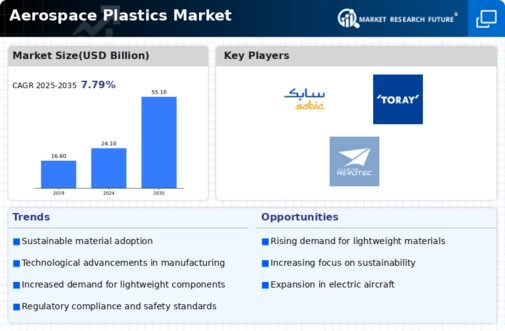Market Analysis
In-depth Analysis of Aerospace Plastics Market Industry Landscape
The Aerospace Plastics Market operates within a dynamic landscape influenced by a variety of factors that collectively shape its growth and trends. Aerospace plastics, comprising high-performance polymers, composites, and thermoplastics, play a crucial role in modern aircraft design, offering lightweight alternatives to traditional materials like metal. The market dynamics of aerospace plastics are intricately linked to trends in the aerospace industry, technological advancements, regulatory standards, and global economic conditions.
A major driver of the aerospace plastics market is the aerospace industry's ongoing quest for lightweight materials to improve fuel efficiency, reduce emissions, and enhance overall aircraft performance. Aerospace plastics offer high strength-to-weight ratios, corrosion resistance, and design flexibility, making them essential in the construction of aircraft components such as interior panels, exterior structures, and engine components. The dynamics of the market respond to the increasing demand for innovative materials that address the challenges of modern aviation.
Technological advancements play a pivotal role in shaping the aerospace plastics market dynamics. Ongoing research and development efforts focus on enhancing the properties of aerospace plastics, including flame resistance, thermal stability, and impact resistance. Innovations in composite manufacturing processes, additive manufacturing techniques, and the development of novel polymer formulations contribute to the production of high-performance aerospace plastics. The market dynamics adapt to these technological breakthroughs, with companies striving to provide advanced solutions that meet the stringent requirements of the aerospace industry.
Regulatory standards and compliance are critical factors influencing the aerospace plastics market dynamics. As the aerospace industry operates within a highly regulated environment, materials used in aircraft must adhere to strict safety and quality standards. Compliance with regulations related to flame retardancy, toxicity, and overall durability becomes integral to the competitive positioning of companies within the market. Companies must stay abreast of evolving regulatory requirements to navigate the complex landscape and ensure market compliance.
Global economic conditions and aerospace activities further contribute to the dynamics of the aerospace plastics market. Economic growth leads to increased demand for new aircraft, driving the need for advanced materials. Conversely, economic downturns may result in a temporary reduction in aircraft production, impacting the dynamics of the aerospace plastics market. The cyclical nature of the aerospace industry adds an element of unpredictability to market trends.
Market dynamics are also influenced by the competitive landscape and regional variations. Companies operating in specific regions may tailor their aerospace plastics products to meet local regulatory requirements and industry practices. The geographical distribution of aerospace manufacturing facilities, the concentration of aviation-related activities, and the availability of skilled labor impact the competitiveness of aerospace plastics suppliers in specific regions. Global players often adapt their strategies to address regional variations and maintain a strong market presence. The level of competition, market consolidation, and strategic alliances within the aerospace plastics market contribute to the overall dynamics of the industry.
Environmental considerations are increasingly influencing the aerospace plastics market dynamics. As sustainability becomes a key focus for the aerospace industry, the dynamics of the market respond to the growing demand for eco-friendly materials. Companies are investing in research and development initiatives to create aerospace plastics with improved recyclability and reduced environmental impact, aligning with the broader trend towards sustainable aviation practices.






Leave a Comment